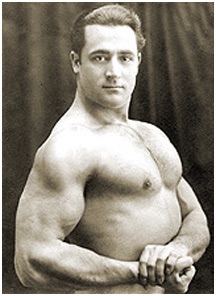When I was growing up a fella named Charles Atlas adorned the back pages of cheap magazines, displaying a body we’d today call “buff” but back then “muscle-bound.” The proverbial answer to being a skinny wimp at the beach and having sand kicked-in-your-face by the big guy who gets the “gals,” Atlas preached the power of “Dynamic Tension”, a muscle-building method we now call “isometrics.”
Isometrics pits one muscle against another – bicep against bicep, for example – slowly and steadily building strength and muscle-mass. Atlas’ use of opposing of forces was not new; Asian martial arts techniques utilize isometric exercise and have done so for many centuries.
The Atlas system was about individual change for personal benefit – no more-sand-in-the -face, lots of gals – but seen in a larger context dynamic tension is actually a phenomenon of social change. Short of war or violence, when opposing societal forces are legally balanced against each other they naturally strengthen society as a whole
We often mistake this creative process and place it merely within the category of competition; given the modern trend of substituting volume for content it’s an easy mistake to make. Opposing points of view often feel antagonistic and hostile and raised voices and harsh language contribute, but underlying surface conflict a vital and important social symmetry operates: the dynamic tension of ideas. It is through this tension progress towards a just society is made, and lacking it just as surely saps society’s strength and vitality. It was this profound realization upon which American democracy was based, despite our present difficulty in sensing it through a thick fog of rhetoric, propaganda and palaver.
In the Atlas system, as one muscle group gained strength it naturally transferred it to the opposing group, and so it is in our democratic system. If any group begins to assume too much strength it stimulates response in its opposite; thus strength of the conservative movement stimulates strength of the liberal, and vice-versa. When working properly, democracy’s tidal ebb and flow of forces results in society inching forward, sometimes agonizingly slow, towards social equity and virtue. Creating a good society requires playing the “long game,” and it’s often hard to be patient while it works its magic.
We easily get caught up in frothiness stirred up by society’s dynamic tension. We demonize the opposition, forgetting that without its force of argument counter arguments would not materialize. In this sense, as terrible we might think an opposing point of view, its expression underlies the emergence of our own. It is this dynamic which over time discards social systems of intolerance and cruelty in favor of decency and compassion. However masked by clouds of incompetence or corruption, the trajectory of human society during the past 5,000 years has been one of relentlessly crawling from under the dark shadow of brutality towards the luminous sunshine of liberation.
To those who still suffer the yoke of oppression and its after effects, the “long game” presents a persistent challenge; the longing for dignity and equity is one of the greatest and most powerful of human forces and cannot be indefinitely suppressed. Admittedly, in our present communication age each act of violence and oppression bears down upon us with an uncomfortable weight of knowing, but when it comes to democracy, as Charles Atlas might have said, “no pain, no gain.”






Charles Atlas, Ltd. is still alive and has been for over 85 years! Look at their website at http://www.charlesatlas.com!
The push-pull strength building tension of isometrics is frozen in place, just as with Congress and much of government. To be useful, that strength must be coordinated into action rather than built into ever more powerful immobility until the structure itself collapses into chaos – a lesson seemingly soon to be learned.